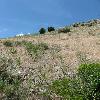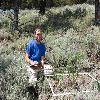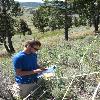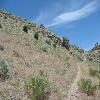Understanding invasion dynamics
A case study for Dalmatian toadflax
We are currently analyzing the spatial-age and spatial-genetic structure of four metapopulations of Dalmatian toadflax. The metapopulations are located within Northern Range of Yellowstone and consist of a large “main” patch, with some metapopulations also having smaller “satellite” patches. Leaf and root samples of more than 75 plants were collected from each metapopulation. When this study is complete we will know the age of the each plant and the genetic relationship between individuals as well as between populations. This data will help us understand the influence of seed dispersal and vegetative growth on patch expansion and the external variables driving the population dynamics.
Inter-simple sequence repeat (ISSR) analysis is being employed to develop phylogenetic maps of our metapopulations. We screened 20 ISSR primers for the number of polymorphic markers generated using L. dalmatica genomic DNA. Four primers where selected on the basis of the reproducibility and quantity of amplified bands. A total of 54 polymorphic molecular markers were scored to establish the relationship between spatial (Euclidean distances) and genetic distances among individual plants within intra- and inter-populations. The degree of genetic variation within and among populations can indicate the directionality of the gene flow over the landscape. This approach has allowed us to tease apart the contribution of vegetative growth and seed dispersal in population expansion as well as begin to identify source/sink populations.
For aging of individual plants, roots were cross sectioned and annual rings identified through herb-chronology staining techniques. Survivorship curves for these individuals showed a decrease in age cohort size with increasing age as we would expect with age-dependent mortality. When incorporated into a quasi-Poisson model, growing season precipitation showed a significant association to cohort size after accounting for age in populations. The maximum age of each satellite population was quantified to determine establishment year.
Click on an image to view as a slideshow.
Metapopulation dynamics of Dalmatian toadflax in the northern range of YNP.
Three modeling methods have been investigated to aid in identifying the factors that most strongly influenced the spatial metapopulation dynamics of Dalmatian toadflax over time in the northern range of YNP. With the unique knowledge of the point in space and time of introduction (1947 garden) and complete census maps created in 1968 and 1970 we have parameterized a modified Hanski incidence function model, a multistate Markov transition model and a MacKensie Occupancy model. The parameterization process will allow identification of important factors governing the early stages of invasion and the predictive potential will be assessed by comparing forecasted distributions with sample observation from 2001 through 2007 transects.
Click on an image to view as a slideshow.







